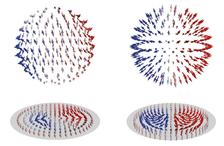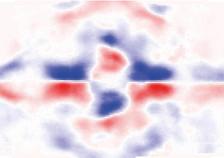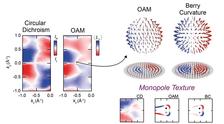Orbital-angular momentum (left) and Berry curvature (right) calculated on a small sphere around a Weyl node and the corresponding azimuthal equidistant projections. For further details see figure below (Credit: partly from original publication).
A team of scientists from the University of Würzburg, Kiel University and DESY and collaborating institutions used PETRA III for their experiments and found a way to trace Berry flux monopoles in a Tantalum arsenide crystal, a special type of magnetic monopole-like object in solids with particular properties.
Physics research has long thrived on the analysis of the symmetries of mathematical constructions that are used to represent the physical world. A large number of elementary particles have been discovered following their prediction from basic considerations and thorough scrutiny of the mathematical formulation of physics theory; as in the year 1929, when the German mathematician and physicist Hermann Weyl analysed the equations that describe elementary particles called fermions. He discovered a simplified version of the previous Dirac description of these charged fermions. This Weyl equation for massless high-energy spin-1/2 fermions, however, found no realisation in nature within the framework of elementary particle physics. Thus, the implications of the equation rather represented a mathematical curiosity than an experimental reality for a long time.
This has changed in the last years when it was understood that electronic states in crystals can effectively behave as high-energy fermions, predicted in elementary particle physics. And some of these materials were indeed discovered, for example Weyl semimetals, like the compound Tantalum arsenide (TaAs). Weyl semimetals feature special crossing points between their valence and conduction bands. If these so-called Weyl points are close to the Fermi energy, the electrons are expected to effectively follow the predictions of the Weyl equation: the spin and the momentum of the particles are aligned either parallel or anti-parallel. In crystals the role of the spin is replaced by a quantity called Berry curvature. At the Weyl points, i.e. at vanishing momentum of the effective Weyl fermion, the Berry curvature forms flux monopoles which behave like magnetic monopoles. They are associated with a non-trivial topology.
With the discovery achieved, an important question remains: how to test the physics predictions independent from abstract theory and to acquire experimental evidence for the existence of Berry flux monopoles in real materials? The team of scientists using the beam from the PETRA III beamline P04 to excite photoelectrons from the TaAs crystals, found a way to trace the Berry curvature in momentum space. This is based on the intricate relation between the Berry curvature and the angular momentum of the electronic movement pattern in the material. This angular momentum can be experimentally probed by the circular dichroism technique, utilising the high degree of circular polarisation of the photon beam. For their measurements, the scientists used the newly developed photoelectron spectrometer ASPHERE III at the PETRA III beamline.
Thereby, evidence for the convergence of the Berry flux lines into monopole points could be obtained. Nature’s response to the question was unambiguous: Weyl’s equation of 1929 was indeed governing the movement pattern of the charge in the material under study. These findings are paving the way to a primarily experimental study of the physics of the novel Weyl semimetals and related materials.
Reference:
Momentum-space signatures of Berry flux monopoles in a Weyl semimetal, M. Ünzelmann, H. Bentmann, T. Figgemeier, P. Eck, J. N. Neu, B. Geldiyev, F. Diekmann, S. Rohlf, J. Buck, M. Hoesch, M. Kalläne, K. Rossnagel, R. Thomale, T. Siegrist, G. Sangiovanni, D. Di Sante and F. Reinert, Nature Communications (2021), DOI: 10.1038/s41467-021-23727-3









